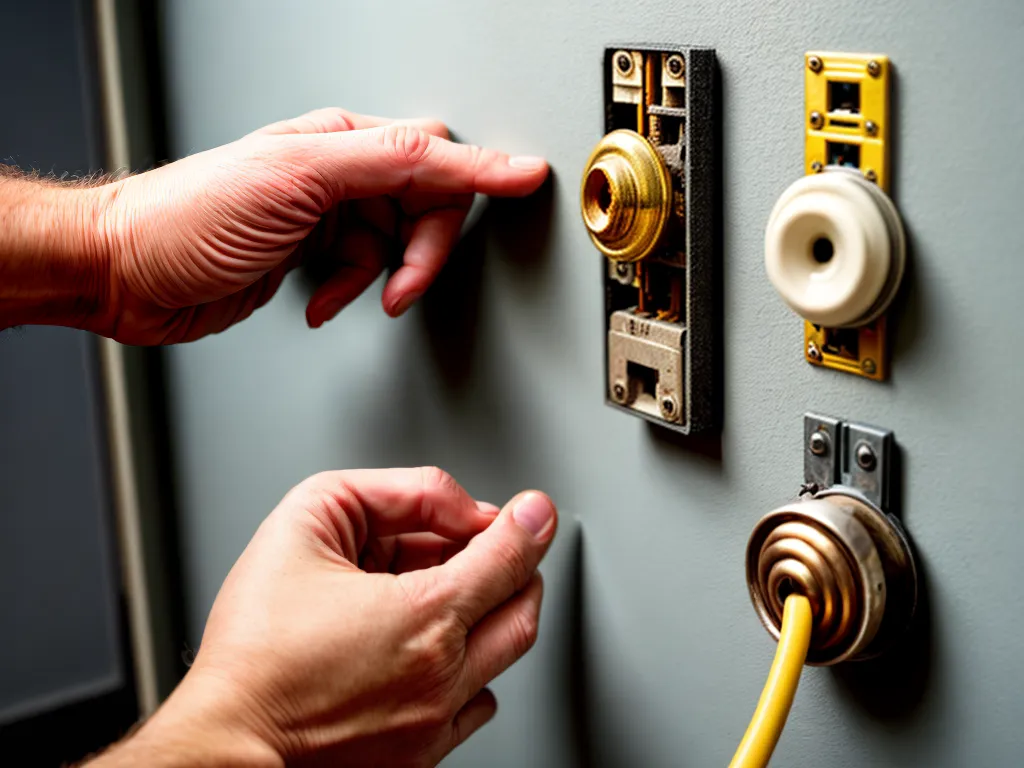
I have an older home that still utilizes original knob-and-tube wiring. This antiquated electrical system was common in homes built before 1950. Maintaining it properly is crucial for safety. With care and vigilance, knob-and-tube can be preserved in a safe manner. In this article, I will share what I have learned about inspecting, repairing, and living with this historical wiring.
What is Knob-and-Tube Wiring?
Knob-and-tube (K&T) consists of electrical cables coated in rubber and cloth insulation. The wires are suspended between ceramic knobs affixed to wall studs and joists. They also pass through ceramic tubes where wires enter boxes or change direction.
This was the standard residential electrical wiring method in North America from about 1880-1930. It eventually was rendered obsolete by newer electrical codes, but remains in many older homes.
Some key attributes of knob-and-tube wiring:
- Separate hot and neutral wires - Unlike modern NM cable, hot and neutral conductors are not bundled together. This minimizes arcing between wires.
- Open air insulation - The wires are not enclosed, leaving airspace between the conductor insulation and framing cavities. This facilitates heat dissipation.
- Higher amperage rating - K&T wires typically used are 8-10 gauge, thicker than modern 15 amp circuits. This affords higher capacity.
Advantages of knob-and-tube:
- Durable, long lasting components
- Resilient insulation minimizing shorts
- Heat dissipation from open air design
Disadvantages:
- Lack of grounding - can't use modern 3-prong outlets
- Difficult to service within walls - access points needed
- Brittle insulation prone to cracking with age
- Arc faults can't be detected without a ground
Inspecting and Assessing Your K&T Wiring
The first step is thoroughly inspecting your home's knob-and-tube wiring to evaluate its current condition. Look for the following:
Exposed Wiring
Visually inspect where wiring passes through attic and basement areas.
-
Is the insulation cracked, fraying or peeled away? This poses a fire and electrocution risk.
-
Are knob insulators broken or missing? This can allow wires to sag or touch combustible materials.
Wall Penetrations
Inspect where wires enter walls and ceilings.
-
Are there loose connections, gaps, or damage around entry holes that allow drafts to enter? This can lead to heat loss.
-
Can you move wires up and down excessively? This indicates deteriorating structural integrity.
Fixtures & Outlets
Assess the light fixtures, switches and outlets connected to K&T circuits.
-
Do they feel warm or make crackling/buzzing noises indicating strain and excessive resistance?
-
Are any devices unusually worn, damaged or improperly installed?
-
Are any modern 3-prong outlets illegally installed on ungrounded K&T wiring? This violates electrical code.
Overload Protection
Verify if your K&T circuits are protected by properly rated fuses or breakers.
-
Old wiring may lack overload protection entirely, or have devices improperly sized for the wire gauge present. This can allow overheating.
-
Breakers should be rated for 15 or 20 amps maximum. Higher amperage fuses suggest K&T has been tapped off improperly.
Making Repairs and Improvements
Where inspection reveals deficiencies in your home's knob-and-tube wiring, prudent repairs should be made for safety. Here are some best practices:
Address Hazards
Any exposed wiring with damaged or cracked insulation should be wrapped in electrical tape or replaced. Support new knobs wherever wires are sagging. Junction boxes should be installed to enclose any loose connections.
Replace any broken ceramic insulators, tubes, or knobs with period authentic reproductions. This maintains historical integrity. Avoid using modern plastic replacements.
Improve Protection
Install period authentic cartridge fuses or pushmatic circuit breakers for overload protection on unprotected K&T circuits. Choose amperage ratings appropriate for the wire size.
Use AFCI or GFCI breakers designed to mitigate arc faults and electrocution risk on ungrounded wiring. These provide critical modern safety with minimum alteration.
Insulate Around Wires
Applying new insulation in attics and walls can further protect K&T wires. Use loose fill or fiberglass batts placed carefully around the existing wiring, leaving a 1" clearance so wires don't overheat.
Limit Alterations
Avoid tapping new pigtail splices off K&T circuits to supply additional outlets. This can easily overload the aged wiring. Instead run new circuits from the main electrical panel.
Never use K&T for high power appliances like dryers; route such loads on dedicated modern wiring. Take special care not to entangle K&T wires within blown-in wall insulation.
Living with Knob-and-Tube Wiring
Exercising caution and following sensible practices can allow continuing use of antique K&T safely.
Use Caution
Treat all accessible knob-and-tube wires as live. Never handle or enclose them until power has been switched off and verified. Wear electrical gloves for any inspections or repairs.
Use plastic wire clips to neatly fasten drooping wires back into place, avoiding direct contact with the aged insulation. Check for heat buildup if circuits are continually overloaded.
Monitor Fixtures
Periodically check light fixtures connected to K&T circuits for signs of overheating. Discolored or cracking lamp sockets indicate potential problems. Flickering lights or warm switches suggest connections in need of repair.
Update Sensibly
Replace original Edison-base screw-in fuses with modern cartridge types for easier overload protection. Install AFCI and GFCI breakers for vital additional protection, without altering the antique wiring itself.
Where repairs prove impractical, selectively replace K&T circuits with new wiring, focusing first on high power appliances. Take advantage of existing wall access points so new cables can coexist with old.
Use Gentle Options
Avoid using spray foam insulation on walls with knob-and-tube, since it completely encapsulates the wires. Opt for blown-in cellulose or fiberglass carefully installed around existing wiring instead.
Conclusion
Knob-and-tube wiring can be retained safely in historic homes through conscientious maintenance and improvement. Take time to thoroughly inspect for deterioration and make repairs as needed. With careful use and monitoring, upgraded protection, and selective replacement, K&T can grace your home reliably for decades to come. Proper precautions will allow you to enjoy the antique character of this venerable wiring safely.